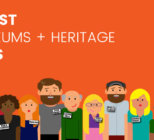It’s no secret that the question of how to increase diversity and inclusion has been an all-too familiar topic across the UK arts sector. Museums and art galleries are commonly deemed expensive and exclusive. In order for these spaces to be more diverse – to showcase more diverse art and to appeal to a more diverse audience – change needs to happen from within. The Arts Council’s 2020/21 Equality, Diversity, Inclusion report found that 77% of managers at NPO’s identified as white, compared to just 9% who identified as Black, Asian and Ethnically Diverse. At every level, there is a clear imperative for diversity – but what can be done to address it?
Use different recruitment methods
From an executive search perspective, it is vital that we consider every element of the search process. When starting a search for any role in a museum, gallery, or any arts organisation, it is tempting to utilise the ‘tried and tested’ avenues that have worked before. However, revisiting the same candidate pools will generally reach the same individuals. Instead, recruiters need to be creative and actively challenge themselves to reach out to individuals not known to them and seek advice and recommendations from diversity-focused networks. Materials for candidates and on the application form should be inclusive and use accessible language as well as provide easy-read and braille options where possible. When looking at applications, recruiters should remind panels of unconscious bias and assist with any training needed in that areas. Interviews are an important part of testing candidates but should be inclusive and accessible to people of all backgrounds. Scheduling video, as well as in-person, interviews is another simple way to break down barriers and ensure it is open for everyone to attend.
Inspire the next generation
Over the past decade, we have witnessed arts organisations perform a much more civic role and increased engagement in community outreach with apprenticeship schemes and youth trustee boards. At Perrett Laver, we are always on the lookout for rising talents with a passion for the arts. At an executive search level, we work with our clients and challenge them to be more open minded about people taking that next step up in the arts. One of our main priorities in the arts practice is tackling diversity and inclusivity in the boardroom. Our Governance Apprenticeship Programme, for example, offers people the opportunity to shadow boards for a year and learn what it is like to be a board member. The goal is that these experiences will inspire them to become a trustee, which can serve as a springboard to inspire the next generation of talent in the arts.
Lead from the front
Fundamentally, change can’t happen unless the status quo demands it. Leaders must set an example from the outset by fostering a holistically inclusive culture where staff want to work. In everything an organisation does, principles of diversity and inclusion must be lived and breathed so that it becomes second nature.
Diversity and inclusion remain a huge priority for the arts sector across the board. Throughout the pandemic, the Black Lives Matter movement sparked change in the sector that should have happened a long time ago. There have been some great initiatives for change, but there is still a long way to go to ensure arts organisations are representative and reflective of the communities they serve. Representation matters because individuals are not going to come to art galleries and museums if they don’t see themselves through the art or the artists, or even the staff who are checking their tickets at the door. The same goes internally as well. People are not going to work somewhere if you they don’t see people like themselves in the workforce.
For those working in executive search, it is our responsibility to guide change that will increase diversity in appointments. And I have no doubt organisations will embrace the momentum towards a more diverse workforce with the persistence, energy and creativity which continues to define the arts.








